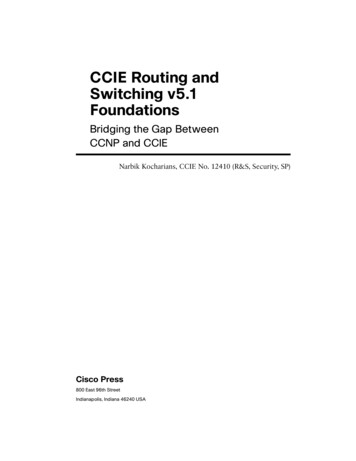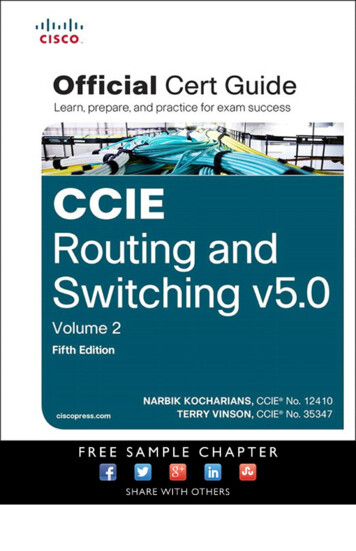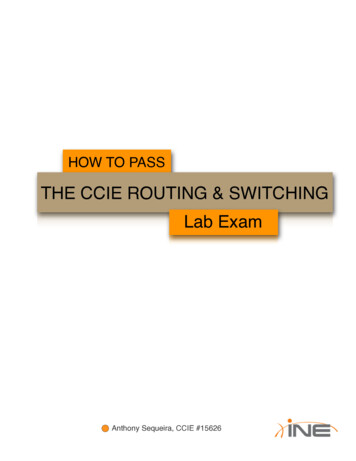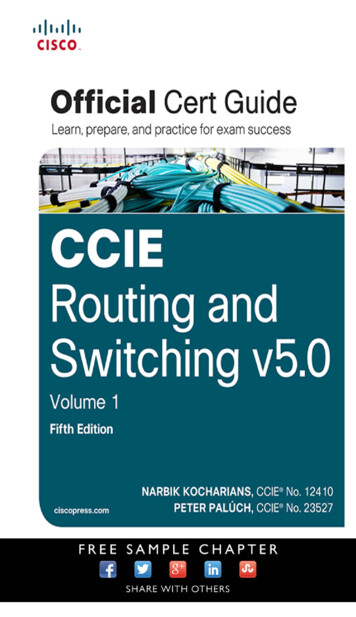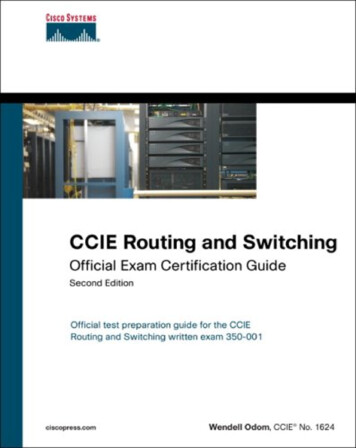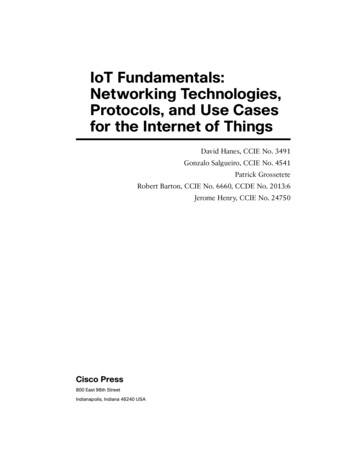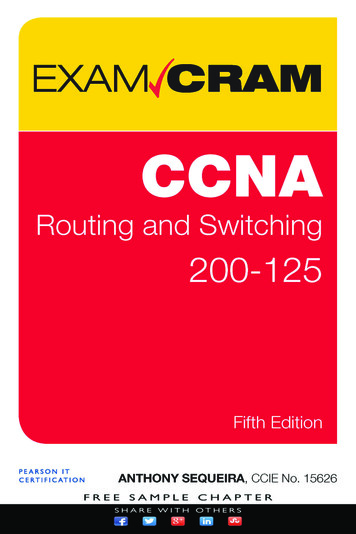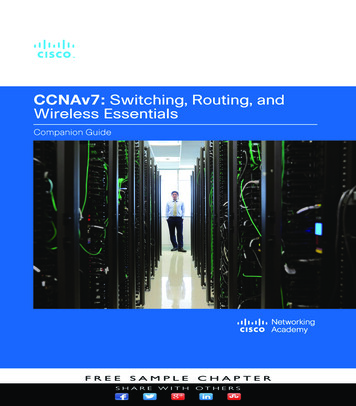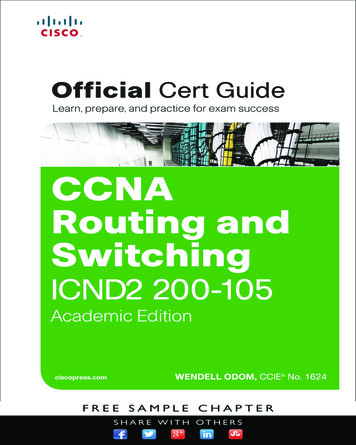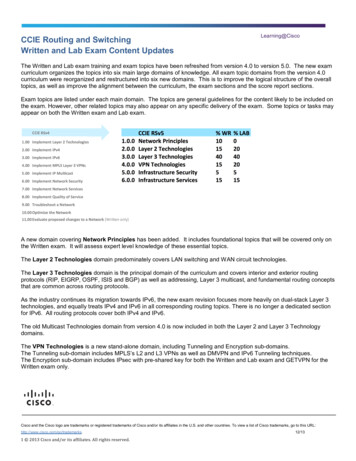
Transcription
CCIE Routing and SwitchingWritten and Lab Exam Content UpdatesLearning@CiscoThe Written and Lab exam training and exam topics have been refreshed from version 4.0 to version 5.0. The new examcurriculum organizes the topics into six main large domains of knowledge. All exam topic domains from the version 4.0curriculum were reorganized and restructured into six new domains. This is to improve the logical structure of the overalltopics, as well as improve the alignment between the curriculum, the exam sections and the score report sections.Exam topics are listed under each main domain. The topics are general guidelines for the content likely to be included onthe exam. However, other related topics may also appear on any specific delivery of the exam. Some topics or tasks mayappear on both the Written exam and Lab exam.A new domain covering Network Principles has been added. It includes foundational topics that will be covered only onthe Written exam. It will assess expert level knowledge of these essential topics.The Layer 2 Technologies domain predominately covers LAN switching and WAN circuit technologies.The Layer 3 Technologies domain is the principal domain of the curriculum and covers interior and exterior routingprotocols (RIP, EIGRP, OSPF, ISIS and BGP) as well as addressing, Layer 3 multicast, and fundamental routing conceptsthat are common across routing protocols.As the industry continues its migration towards IPv6, the new exam revision focuses more heavily on dual-stack Layer 3technologies, and equally treats IPv4 and IPv6 in all corresponding routing topics. There is no longer a dedicated sectionfor IPv6. All routing protocols cover both IPv4 and IPv6.The old Multicast Technologies domain from version 4.0 is now included in both the Layer 2 and Layer 3 Technologydomains.The VPN Technologies is a new stand-alone domain, including Tunneling and Encryption sub-domains.The Tunneling sub-domain includes MPLS’s L2 and L3 VPNs as well as DMVPN and IPv6 Tunneling techniques.The Encryption sub-domain includes IPsec with pre-shared key for both the Written and Lab exam and GETVPN for theWritten exam only.Cisco and the Cisco logo are trademarks or registered trademarks of Cisco and/or its affiliates in the U.S. and other countries. To view a list of Cisco trademarks, go to this URL:http://www.cisco.com/go/trademarks.12/13
CCIE Routing and SwitchingWritten and Lab Exam Content UpdatesLearning@CiscoThe Infrastructure Security domain includes Device Security and Network Security (both focusing on features supportedon ISR routers and Catalyst 3K switches). It excludes any topic that relies on dynamic crypto (PKI) or on any remoteservers.The Infrastructure Services domain includes System Management, Network Services, Quality of Services (QoS) andNetwork Optimization. Layer 2 QoS topics are included in the Written exam only, supporting the Lab exam to focus onplatform independent concepts.Another notable change to the exam topics is the inclusion of weighting factors for each of the six main domains thatrepresent the relative amount of subject knowledge and focus that can be expected in each area for either the Written orthe Lab exam. The main focus of the exam is certainly the Layer 3 technologies, covering 40% of the curriculum.CCIE Routing and Switching v5.0 Topic ChangesThe decisions regarding which topics should be added, moved or retired were based on feedback received from keyindustry Subject Matter Experts (SME). These decisions reflect the evolution of the expectations of a candidateperforming on the job role.Topics Added to the CCIE Routing and Switching v5.0 Written Exam: Describe basic software architecture differences between IOS and IOS XE Identify Cisco Express Forwarding Concepts Explain General Network Challenges Explain IP, TCP and UDP Operations Describe Chassis Virtualization and Aggregation Technologies Explain PIM Snooping Describe WAN Rate-based Ethernet Circuits Describe BGP Fast Convergence Features ISIS (for IPv4 and IPv6) Describe Basic Layer 2 VPN - Wireline Describe Basic L2VPN - LAN Services Describe GET VPN Describe IPv6 Network Address TranslationTopics Added to the CCIE Routing and Switching v5.0 Written and Lab Exams: Use IOS Troubleshooting Tools Apply Troubleshooting Methodologies Interpret Packet Capture Implement and Troubleshoot Bidirectional Forwarding Detection Implement EIGRP (multi-address) Named Mode Implement, Troubleshoot and Optimize EIGRP and OSPF Convergence and Scalability Implement and Troubleshoot DMVPN (single hub) Implement and Troubleshoot IPsec with pre-shared key Implement and Troubleshoot IPv6 First Hop SecurityCisco and the Cisco logo are trademarks or registered trademarks of Cisco and/or its affiliates in the U.S. and other countries. To view a list of Cisco trademarks, go to this URL:http://www.cisco.com/go/trademarks.12/13
CCIE Routing and SwitchingWritten and Lab Exam Content UpdatesLearning@CiscoTopics Moved from the CCIE RS v4.0 Lab exam to the CCIE RS v5.0 Written Exam: Describe IPv6 Multicast Describe RIPv6 (RIPng) Describe IPv6 Tunneling Techniques Describe Device Security using IOS AAA with TACACS and RADIUS Describe 802.1x Describe Layer 2 QoS Identify Performance Routing (PfR)Topics Removed from the CCIE RS v4.0 Exam: Flexlink, ISL, Layer 2 Protocol Tunneling Frame-Relay (LFI, FR Traffic Shaping) WCCP IOS Firewall and IPS RITE, RMON RGMP RSVP QoS, WRR/SRRCCIE Routing and Switching v5.0 Exam FormatAlthough the exam number is changed from 350-001 to 400-101, the new Written exam format remains essentially thesame as the previous one.The format of the Lab exam has some significant changes that you need to be aware of.The web-based delivery infrastructure supporting the new Lab exam is actually very similar to the one used to deliver theprevious version 4.0, however, the configuration portion of the exam is now delivered using virtual devices – just like thetroubleshooting portion of the exam. Virtual routers and virtual switches will be used throughout the exam, supportingmore realistic and bigger network topologies that improve the reliability of the test while focusing on conceptualtechnologies – rather than testing specific hardware platform peculiarities.Just like with the CCIE Routing and Switching v4.0, the Troubleshooting module delivers incidents that are independent ofeach other, meaning that the resolution of one does not depend on the resolution of another incident.Cisco and the Cisco logo are trademarks or registered trademarks of Cisco and/or its affiliates in the U.S. and other countries. To view a list of Cisco trademarks, go to this URL:http://www.cisco.com/go/trademarks.12/13
CCIE Routing and SwitchingWritten and Lab Exam Content UpdatesLearning@CiscoThis is designed in order to objectively quantify the troubleshooting skills and avoid bias of strengths and weaknesses inspecific technical areas.On the contrary, the Configuration module presents candidates with a whole scenario composed of multiple items that aremeant to be inter-dependent, by nature of the infrastructure technologies. Candidates do see all items at the beginning ofeach exam module. They can work out the sequence that they want to address each item as well as manage the timespent to resolve each item.A new exam module called “diagnostic module” has been added and will focus on the skills required to properly diagnosenetwork issues. The time for this new lab module is fixed to 30 minutes, no more or no less.The sequence of delivery of these three lab modules is fixed as follows: Troubleshooting module, then the Diagnosticmodule and finally the Configuration module.Although the time constraint is an essential component of the Troubleshooting module, the system enables some flexibilityby granting candidates the option to extend up to 30 minutes to complete the module. The system doesn’t allow goingback and forth between modules and the Diagnostic module is fixed to 30 minutes. In order to maintain the total examtime to 8 hours, the optional extra time used in the Troubleshooting module will automatically be deducted from the timecredit allotted for the Configuration module. On the contrary, if the time spent in the Troubleshooting module is less than 2hours, the Configuration module is credited by the time gained.The web-based delivery system will display a warning message after two hours have passed within the Troubleshootingmodule, informing the candidate that if they proceed in the Troubleshooting module, any additional time used (up to thirtyminutes) will be reduced from the Configuration time, ensuring that the total exam is a maximum eight hours.In order to pass the lab exam, a candidate must meet two separate conditions. First, the sum of scores of each modulemust exceed the overall lab exam cut-score. Second, the score achieved for each module must exceed the module’sminimum score. This is done to prevent from passing the lab exam while failing or even bypassing the shortest Diagnosticmodule. While the exact lab exam overall cut-score remains confidential, the overall pass/fail decision is made on theverification if all specific criterion for each exam item are met. The point value of each item is shown on the test andscores are granted only when all criterion are met. No partial score is granted for any items (all items are multi-pointdichotomous items).As briefly mentioned above, the objective of the new Diagnostic module is to further assess the skills required to properlydiagnose network issues. These skills include “analyzing, correlating and discerning multiple sources of documentation”such as email threads, network topology diagrams, console outputs, syslogs and even traffic captures. These activitiesare naturally part of the overall Troubleshooting activities. They were designed as a separate lab module because theformat of the items is significantly different. The Troubleshooting incidents require candidates to resolve networking issuesby configuring possible solutions (while not breaking any explicit constraints) and verifying that the symptoms are fixed,using terminal sessions to the console port of actual devices.In contrast, the Diagnostic module tickets require candidates to make a choice between pre-defined options in order to: indicate what the root cause of an issue isor where is the issue located in a diagramor what is the critical piece of information leading to identifying the root causeor what piece of information is missing to make a judgment about the root causeCisco and the Cisco logo are trademarks or registered trademarks of Cisco and/or its affiliates in the U.S. and other countries. To view a list of Cisco trademarks, go to this URL:http://www.cisco.com/go/trademarks.12/13
CCIE Routing and SwitchingWritten and Lab Exam Content UpdatesLearning@CiscoThe Diagnostic module doesn’t require using terminal sessions to actual devices. It provides candidates with a set ofdocumentation that represent a snapshot of a realistic situation, at a point in time in the investigation process that anetwork engineer might be confronted with. For instance, a support engineer might need to provide the root causeanalysis to a customer, or might need to help a colleague who is stuck on a problem, or might have to summarize theprevious investigations stepsJWithin the Diagnostic module, the format of some of the tickets presented is similar to the format of the Written exam. Itincludes multiple-choice (single answer or multiple answers), Drag and Drop, or even Point and Click on diagrams. Thebiggest difference with the Written exam is that tickets will contain a set of documentation that candidates must consult inorder to understand the issue. Then in turn, analyze and correlate information (after discerning between valuable andworthless pieces) in order to make a choice among pre-defined options.Tickets will not require candidates to write anything in order to provide the answer to a ticket. All tickets will be closeended (as opposed to open-ended) so that the grading will be deterministic, ensuring a fair and consistent scoring. Thisapproach also helps to grant credit and scores for accurately identifying the root cause of a networking issue but failing toresolve it within the defined constraints – which the Troubleshooting module doesn’t offer.Real-life experience is certainly the best training to prepare for the module. However, it is also naturally embedded whentraining for the Troubleshooting module. Candidates with limited experience should focus on discovering, practicing andapplying efficient and effective troubleshooting methodologies that can be applied for any realistic networking challenge.We trust that this new Diagnostic module greatly improves the overall value of the certification by focusing on valuableskills unique to experienced and talented engineers.Cisco and the Cisco logo are trademarks or registered trademarks of Cisco and/or its affiliates in the U.S. and other countries. To view a list of Cisco trademarks, go to this URL:http://www.cisco.com/go/trademarks.12/13
CCIE Routing and SwitchingWritten and Lab Exam Content UpdatesLearning@CiscoCCIE Routing and Switching v5.0 Recommended Hardware and Software EquipmentThis latest revision assesses knowledge of platform-independent concepts that are applicable across the portfolio ofrouters and switches. They are based on functionalities available in Cisco IOS Software Release 15 running within a100% virtual environment.In order to become familiar with the virtualized IOS lab environment, training is available through the Cisco 360 LearningProgram. The product offerings include Pre-assessment Labs, Practice Lab Workbooks, and all labs associated with theCIERS1 and CIERS2 Instructor Led Trainings.Candidates who want to prepare using hardware based labs can use the following equipment and Cisco IOS SoftwareReleases: Cisco ISR 2900 Series routers running IOS version 15.3T Universal Software releaseCatalyst 3560X Series switches running IOS version 15.0SE Universal (IP Services) Software releaseAny other hardware platform that can run equivalent Cisco IOS Software version 15 may be used as well.Note that older equipment platforms and Cisco IOS Software Releases may be used to learn and practice a significantportion of the exam curriculum. Refer to the Cisco Feature Navigator (www.cisco.com/go/fn) to compare Cisco IOSSoftware Releases.CCIE Routing and Switching v5.0 ResourcesAlong with the changes to the version 5.0 curriculum, new material will be released in the Cisco 360 Learning Programbeginning in January 2014. The material is being revised to include new virtual rack rentals, videos on demand, newworkbook labs, full scale graded assessment labs, as well as new classes. The most exciting part of this program is thenew release of the virtual equipment rental that is needed to perform the workbook and technology specific labs using anefficient and scalable delivery environment.As you certainly know, the Cisco Learning Network is a social learning network designed for networking professionalsacross the globe. It hosts all official information regarding Cisco Certifications, including the exam Topics.Please visit learningnetwork.cisco.com for more information regarding the CCIE Routing and Switching v5.0.Cisco and the Cisco logo are trademarks or registered trademarks of Cisco and/or its affiliates in the U.S. and other countries. To view a list of Cisco trademarks, go to this URL:http://www.cisco.com/go/trademarks.12/13
CCIE Routing and Switching v5.0 Exam Format Although the exam number is changed from 350-001 to 400-101, the new Written exam format remains essentially the same as the previous one. The format of the Lab exam has some significant changes that you need to be aware of.File Size: 2MB
